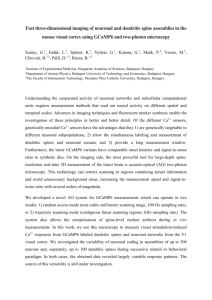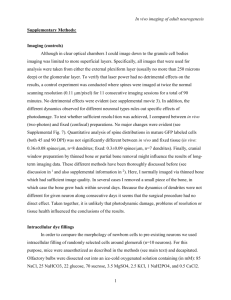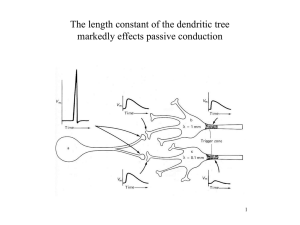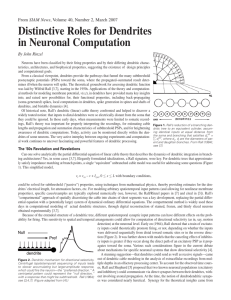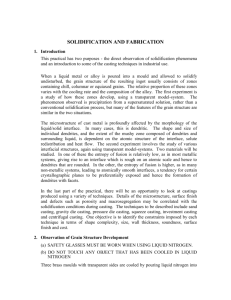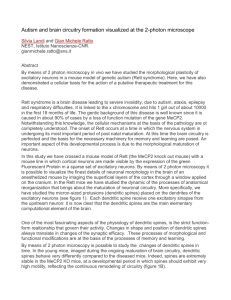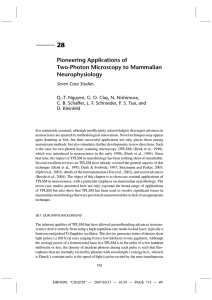BOX 11.3 IMAGING DENDRITIC FUNCTION The microscope was
advertisement
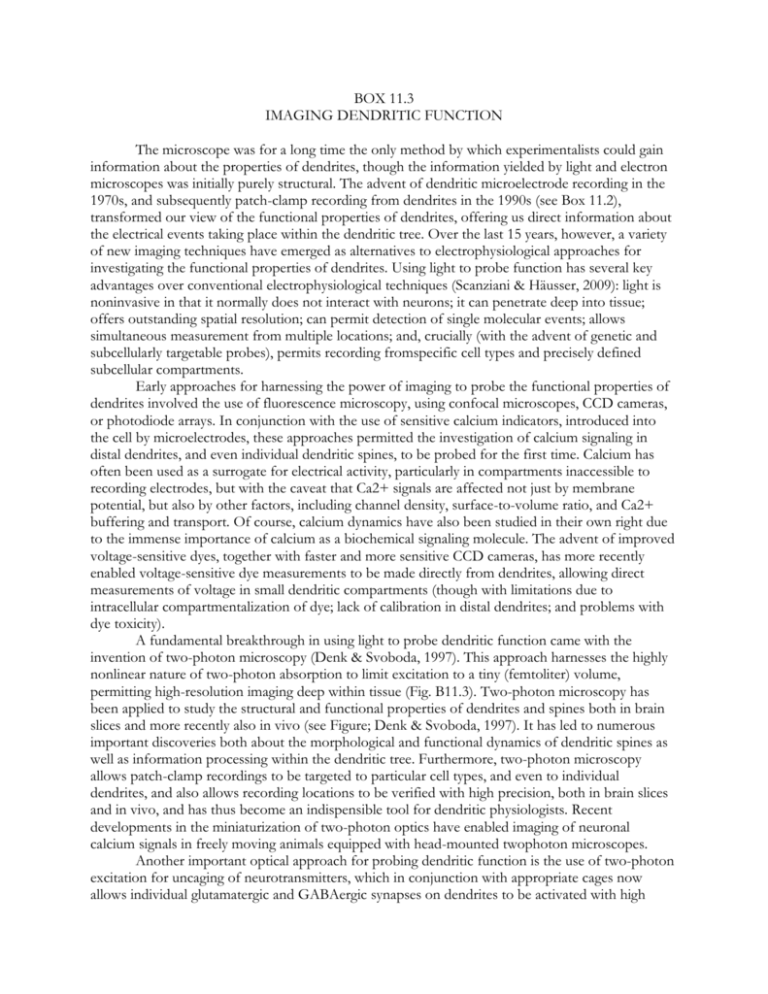
BOX 11.3 IMAGING DENDRITIC FUNCTION The microscope was for a long time the only method by which experimentalists could gain information about the properties of dendrites, though the information yielded by light and electron microscopes was initially purely structural. The advent of dendritic microelectrode recording in the 1970s, and subsequently patch-clamp recording from dendrites in the 1990s (see Box 11.2), transformed our view of the functional properties of dendrites, offering us direct information about the electrical events taking place within the dendritic tree. Over the last 15 years, however, a variety of new imaging techniques have emerged as alternatives to electrophysiological approaches for investigating the functional properties of dendrites. Using light to probe function has several key advantages over conventional electrophysiological techniques (Scanziani & Häusser, 2009): light is noninvasive in that it normally does not interact with neurons; it can penetrate deep into tissue; offers outstanding spatial resolution; can permit detection of single molecular events; allows simultaneous measurement from multiple locations; and, crucially (with the advent of genetic and subcellularly targetable probes), permits recording fromspecific cell types and precisely defined subcellular compartments. Early approaches for harnessing the power of imaging to probe the functional properties of dendrites involved the use of fluorescence microscopy, using confocal microscopes, CCD cameras, or photodiode arrays. In conjunction with the use of sensitive calcium indicators, introduced into the cell by microelectrodes, these approaches permitted the investigation of calcium signaling in distal dendrites, and even individual dendritic spines, to be probed for the first time. Calcium has often been used as a surrogate for electrical activity, particularly in compartments inaccessible to recording electrodes, but with the caveat that Ca2+ signals are affected not just by membrane potential, but also by other factors, including channel density, surface-to-volume ratio, and Ca2+ buffering and transport. Of course, calcium dynamics have also been studied in their own right due to the immense importance of calcium as a biochemical signaling molecule. The advent of improved voltage-sensitive dyes, together with faster and more sensitive CCD cameras, has more recently enabled voltage-sensitive dye measurements to be made directly from dendrites, allowing direct measurements of voltage in small dendritic compartments (though with limitations due to intracellular compartmentalization of dye; lack of calibration in distal dendrites; and problems with dye toxicity). A fundamental breakthrough in using light to probe dendritic function came with the invention of two-photon microscopy (Denk & Svoboda, 1997). This approach harnesses the highly nonlinear nature of two-photon absorption to limit excitation to a tiny (femtoliter) volume, permitting high-resolution imaging deep within tissue (Fig. B11.3). Two-photon microscopy has been applied to study the structural and functional properties of dendrites and spines both in brain slices and more recently also in vivo (see Figure; Denk & Svoboda, 1997). It has led to numerous important discoveries both about the morphological and functional dynamics of dendritic spines as well as information processing within the dendritic tree. Furthermore, two-photon microscopy allows patch-clamp recordings to be targeted to particular cell types, and even to individual dendrites, and also allows recording locations to be verified with high precision, both in brain slices and in vivo, and has thus become an indispensible tool for dendritic physiologists. Recent developments in the miniaturization of two-photon optics have enabled imaging of neuronal calcium signals in freely moving animals equipped with head-mounted twophoton microscopes. Another important optical approach for probing dendritic function is the use of two-photon excitation for uncaging of neurotransmitters, which in conjunction with appropriate cages now allows individual glutamatergic and GABAergic synapses on dendrites to be activated with high temporal and spatial precision. This approach has allowed the inputoutput function of individual dendrites to be probed with unrivalled temporal and spatial precision (e.g., Branco, Clark, & Häusser, 2010) and has also permitted the investigation of dendritic plasticity rules. There is currently tremendous enthusiasm about the use of imaging techniques for examining dendritic function, driven by advances in microscope resolution (Hell, 2007), innovative sample preparation (Micheva & Smith, 2007), and development of new sensors (Miyawaki, 2011). In particular, the advent of new genetically encoded probes for calcium, voltage, and a variety of signal transduction molecules, as well as the ability to target these probes to specific cell types and/or subcellular compartments, promise to offer us unprecedented insights into both electrical and chemical signaling in the most distal corners of dendritic trees. While electrophysiological approaches will probably always maintain their status as the “gold standard” for investigating electrical signaling in dendrites, due to their superior sensitivity and temporal resolution (Scanziani & Häusser, 2009), it is clear that optical solutions for probing dendritic function will become increasingly popular. FIGURE B11.3 Using optical techniques to probe dendritic function. (A) A cuvette filled with a fluorescent dye is illuminated with either one-photon or two-photon excitation (top and bottom objectives, respectively). Note the remarkable spatial precision of the two-photon excitation. (B) In vivo imaging of dendritic calcium signaling. Left, a single layer 2/3 pyramidal cell in an anaesthetized rat is filledwith a calcium dye (Oregon Green BAPTA-1) via a somatic patch-clamp recording and imaged using 2-photonmicroscopy. Right, Ca2+ transients (averages of 3–5 trials) that were evoked by single backpropagating action potentials at the positions indicated along the dendrite. (C) Probing computational properties of single dendrites using two-photon glutamate uncaging. (a) A pyramidal cell in a neocortical slice is filled with a fluorescent dye via a somatic patch pipette. (b) Spines along a single dendrite are imaged using two-photon microscopy, and the dendrite is bathed with a caged glutamate compound (MNI-glutamate). Synaptic transmission is then mimicked by brief two-photon uncaging at individual spines (yellow dots). (c) The synapses are activated in a sequence, eithermoving towards the soma (ON, red trace), or away fromthe soma (OFF, blue trace), producing a directionally selective EPSP at the soma. Sources: (A) Courtesy of Brad Amos, MRC, LMB, Cambridge; (B) Waters et al., 2003; (C) Branco et al., 2010.
